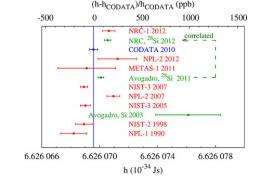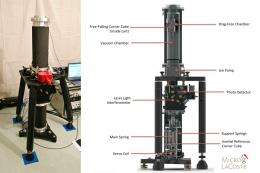The great gravity showdown

During the week of February 6-10, 2012, some extremely weighty matters were in progress at NIST’s non-magnetic facility, where PML researchers hosted an international gravimeter shoot-out with potentially momentous consequences for the impending redefinition of the kilogram.
All night, every night, in a special “gravity room” within a few meters of the NIST3 watt balance, four independent Canadian and American teams used nearly identical instruments at the same location to take over 20,000 repeated measurements of the local force of gravity. Each team is now independently processing and analyzing its data, and the results will be shared as early as March 2012.
The project, called the 2012 North American Watt Balance Absolute Gravity Comparison (NAWBAG-2012), is a collaborative effort intended to help resolve a vexing discrepancy between two published values for the Planck constant – one from NIST and the other from the National Research Council of Canada (NRC) -- which were made by comparing electrical to mechanical power using watt balances. The difference (see Figure 2) is too great to be explained by the reported uncertainties in operation of each of the complex devices.

That leaves the world metrology community with a problem: In the method believed most likely to be adopted by the Bureau international des poids et mesures (BIPM) to redefine the kilogram, an exact determination of the Planck constant is essential. And to measure the Planck constant on a watt balance, the local acceleration of gravity, g, must be known to high precision. Hence the importance of a head-to-head comparison of the gravimeters used by each watt-balance team.
The comparison data will be presented at the 2012 Conference on Precision Electromagnetic Measurements (CPEM -2012, to be held July 1-6 in Washington, DC). “If there is a substantial difference between instruments,” says Jon Pratt, who heads the Fundamental Electrical Measurements group in PML’s Quantum Measurement Division, “it could go a long way toward explaining the discrepancy between our Planck constant measurements and the NRC’s. Then we could adjust the appropriate gravity value in an attempt to reconcile the difference.
“If, on the other hand, all the gravimeters produce results in good agreement, we will have to look for other causes. For example, both groups are working to develop new tests to look for deviations in their magnetic, electrical or mechanical sub-systems that might contribute to the apparent bias between the balances.”
NAWBAG-2012 also had another major benefit in providing a direct comparison of the absolute gravimeters employed by major government entities in North America, including the U.S. National Oceanic and Atmospheric Administration (NOAA) and Natural Resources Canada (NRCan). “The participation of NOAA and NRCan,” says PML physicist David Newell, who set up and operated NIST’s absolute gravimeter for NAWBAG-2012 and coordinated the event, “provides the foundation of a more accurate North American joint gravity network. A more accurate gravity network will allow a better determination of earth mass deformations from effects such as post-glacial rebound and mass redistribution in seismically active areas.”
The NIST-NRC comparison is only one element of a top-to-bottom investigation of the existing NIST watt balance, NIST3, in search of any possible sources of error that can be eliminated to improve its uncertainty figures. “NIST is performing a complete reproducibility evaluation of every component of NIST3,” continues Newell, “and g is one of the key factors.
“Of course, we cannot measure g at the exact location of the watt balance test mass because the apparatus is in the way. But using various methods, we can extrapolate a value that is within a few parts in a billion.”
Provided by National Institute of Standards and Technology











.jpg)






